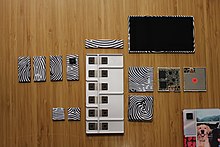
A smartphone, often simply called a phone, is a mobile device that combines the functionality of a traditional mobile phone with advanced computing capabilities. It typically has a touchscreen interface, allowing users to access a wide range of applications and services, such as web browsing, email, and social media, as well as multimedia playback and streaming. Smartphones have built-in cameras, GPS navigation, and support for various communication methods, including voice calls, text messaging, and internet-based messaging apps.

Motorola Mobility LLC, marketed as Motorola, is an American consumer electronics manufacturer primarily producing smartphones and other mobile devices running Android. Headquartered at Merchandise Mart in Chicago, Illinois, it is a subsidiary of the Chinese technology company Lenovo.
JVL Ventures, LLC d/b/a Softcard, was a joint venture between AT&T, T-Mobile and Verizon which produced a mobile payments platform known as Softcard, which used near-field communication (NFC) technology to allow users to pay for items at stores and restaurants with credit and debit card credentials stored on their smartphones. The partnership was first announced on November 16, 2010; following a trial period in 2012, the service officially launched nationwide on November 14, 2013. The official Softcard app was available for NFC-compatible smartphones using the Android operating system and later on Windows Phone 8.1.

Regina E. Dugan, is an American businesswoman, inventor, technology developer and government official. She was the first female director of the Defense Advanced Research Projects Agency (DARPA), where she served from July 2009 until March 2012.

Lenovo smartphones are marketed as the "LePhone" in mainland China and the "IdeaPhone" overseas are smartphones designed and manufactured by the Motorola Mobility, ZUK Mobile and Medion, divisions of Lenovo. On April 27, 2017, Lenovo announced that the ZUK brand would cease operations. In 2015, Lenovo subsumed its own smartphone division into the acquired Motorola brand.

The Nexus 6 is a phablet co-developed by Google and Motorola Mobility that runs the Android operating system. It is the successor to the Nexus 5, and the sixth smartphone in the Google Nexus series, which is a family of Android consumer devices marketed by Google and built by an original equipment manufacturer partner. The Nexus 6 and the HTC Nexus 9 served as the launch devices for Android 5.0 "Lollipop".

Moto X is an Android smartphone developed and manufactured by Motorola Mobility, and released in August 2013.

Phonebloks is a modular smartphone concept created and designed by the Dutch designer Dave Hakkens in 2013, primarily to reduce electronic waste. While Phonebloks is not the first attempt at modular design in a phone, it is notable due to the extent of its modularity and the attention and support it has gained. By attaching individual third-party components to a main board, a user would create a personalized smartphone. These bloks can be replaced at will to replace a broken blok, to upgrade an existing blok, or to expand the functionality of the phone into a specific direction. Bloks would be available in Blokstore, "an app store for hardware", where users could buy new and used bloks as well as sell back their old ones.

The Moto G is an Android smartphone developed and manufactured by Motorola Mobility, at the time a subsidiary of Google. Released on 13 November 2013, the phone was initially aimed at emerging markets, although it was also available in developed markets as a low-price option.

Tango was an augmented reality computing platform, developed and authored by the Advanced Technology and Projects (ATAP), a skunkworks division of Google. It used computer vision to enable mobile devices, such as smartphones and tablets, to detect their position relative to the world around them without using GPS or other external signals. This allowed application developers to create user experiences that include indoor navigation, 3D mapping, physical space measurement, environmental recognition, augmented reality, and windows into a virtual world.

The second generation Moto X, marketed as moto X and referred to in the media as Moto X (2014), is an Android smartphone developed by Motorola Mobility. Released on September 5, 2014, it is the successor to the original Moto X released in 2013. It was succeeded by the third generation Moto X Style and Play family, announced on July 29, 2015.

Paul Eremenko is a Ukrainian American innovator and technology executive. He was formerly the Chief Technology Officer and Senior Vice President of United Technologies Corporation. Earlier, he served as the CTO of Airbus, and former CEO of Airbus Silicon Valley innovation center. He is a former Google executive and head of Google's Project Ara, an effort to create an open, modular smartphone platform. Eremenko was named one of the Top-10 Tech Leaders of 2015 in FORTUNE Magazine. Eremenko has also come out as a strong proponent of artificial intelligence and autonomy research. Eremenko has cited his desire to build a starship as the motivation underpinning his career.

A modular smartphone is a smartphone designed for users to upgrade or replace components and modules without the need for resoldering or repair services. The most important component is the main board, to which others such as cameras and batteries are attached. Components can be obtained from open-source hardware stores.

The Fairphone 2 is a touchscreen-based, dual-SIM smartphone designed to be easily repaired by the user. First released in October 2015, it was the first modular smartphone available for purchase and has since received both hardware improvements and major software updates, initially shipping with Android 5 "Lollipop" and running Android 10 as of November 2022. Production ceased in 2018.

Google's Advanced Technology and Projects group (ATAP) is a skunkworks team and in-house technology incubator, created by former DARPA director Regina Dugan. ATAP is similar to X, but works on projects, granting project leaders time—previously only two years—in which to move a project from concept to proven product. According to Dugan, the ideal ATAP project combines technology and science, requires a certain amount of novel research, and creates a marketable product. Historically, the ATAP team was born at Motorola Mobility and kept when Google sold Motorola Mobility to Lenovo in 2014; for this reason, ATAP ideas have tended to involve mobile hardware technology.

The Moto G4 is a line of Android smartphones manufactured by Motorola Mobility, a subsidiary of Lenovo. It is the successor to the third-generation Moto G, and was first released in Brazil and India on May 17, 2016, with other markets following.

Moto Z is an Android smartphone developed by Motorola Mobility. Unveiled on June 9, 2016, as its flagship model for the year, the Moto Z is distinguished by the "Moto Mods" technosystem which allows case accessories to be magnetically attached to the device to provide additional functionality. The Moto Z was later joined by the more rugged Moto Z Force of which shares most of the same internals as the former, and the mid-range Moto Z Play with downgraded specifications, all three devices being compatible with the modular system.

Iqbal Arshad is an American engineer, inventor, speaker and technology executive. He has served as the senior vice president of engineering and global product development at Motorola Mobility, Google and Lenovo, and has been responsible for design and development of industry-leading smartphones, tablets smartwatches, wearables, silicon, and mobile computing technologies.

A foldable smartphone is a smartphone with a folding form factor. It is reminiscent of the clamshell design of many earlier feature phones. Some variants of the concept use multiple touchscreen panels on a hinge, while other designs utilise a flexible display. Concepts of such devices date back as early as Nokia's "Morph" concept in 2008, and a concept presented by Samsung Electronics in 2013, while the first commercially available folding smartphones with OLED displays began to emerge in November 2018.
The Moto Z3 is an Android smartphone developed by Motorola Mobility, as the successor to the Moto Z2 Force Edition. It is the world's first 5G-upgradable smartphone. Like all of Motorola's smartphones in the Moto Z series, it supports Motorola's magnetically attachable "MotoMods" modules.



















